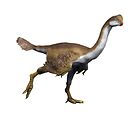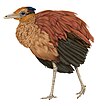纤手龙属
| 纤手龙属 化石时期:上白堊紀
| |
|---|---|

| |
| 正模标本的手部 | |
| 科学分类 | |
| 界: | 动物界 Animalia |
| 门: | 脊索动物门 Chordata |
| 纲: | 蜥形纲 Sauropsida |
| 总目: | 恐龍總目 Dinosauria |
| 目: | 蜥臀目 Saurischia |
| 亚目: | 獸腳亞目 Theropoda |
| 科: | †近颌龙科 Caenagnathidae |
| 亚科: | †单足龙亚科 Elmisaurinae |
| 属: | †纤手龙属 Chirostenotes Gilmore,1924 |
| 模式種 | |
| 纤瘦纤手龙 Chirostenotes pergracilis Gilmore,1924
| |
| 異名 | |
| |
纤手龙属(学名:Chirostenotes,意为“狭窄的手”)是生活在7650万年前,白垩纪晚期加拿大艾伯塔的偷蛋龙类。其模式种为纤瘦纤手龙(C.pergracilis)。
描述
[编辑]纤手龙有着末端纤细的长手臂、长爪子和具有纤细脚趾的长腿,约2米(6.6英尺)长。纤手龙有可能是杂食动物或食草动物,这是根据其近亲安祖龙属和近颌龙属的喙所推断。
2005年,Phil Senter和J. Michael Parrish公布了关于纤手龙手部的用途以及其细长的第二根手指与直爪可能用作缝隙探测适应的证据的研究。他们提出纤手龙可能以第二根爪刺穿软体动物为食,如蛴螬、无装甲的两栖类、爬行类和哺乳类。[1]然而,若纤手龙第二根手指附有如尾羽龙的大型初级飞羽,那纤手龙可能没有办法做到这点。[2]
分类历史
[编辑]
纤手龙有着在发现和命名方面的困惑历史。其第一个化石,一对手部,于1914年由George F. Sternberg在加拿大恐龙公园地层附近发现,该公园地层是加拿大内最多恐龙的地点。后来这个标本由劳伦斯·赖博研究,赖博后来在逝世前为该标本命名。1924年,查尔斯·W·吉尔摩采纳了赖博在笔记里所提到的名字并将其模式种命名为纤瘦纤手龙(Chirostenotes pergracilis),属名在希腊语意为“手”和“狭隘”,种名则意为“始终”和拉丁语的“纤细”。正模标本为NMC 2367,即之前提到的手部化石。[3]另外一个和纤手龙有关的化石为CMN 8776标本,一组颌部及怪状的牙齿,原本被吉尔摩称为纤瘦纤手龙。现已得知纤手龙是不具有牙齿的偷蛋龙类,颌部化石后来被命名为理查德伊斯特斯龙属(Richardoestesia),而该恐龙可能则属于驰龙科。[4]
纤手龙这个名字是第一个指定所用名字。纤手龙的脚部后来被发现,标本编号为CMN 8538,Charles Mortram Sternberg过后在1932年命名为加拿大大趾龙(Macrophalangia canadensis),意为“来自加拿大的大脚趾”。[5]Sternberg正确地识别其为肉食性恐龙,但却将其分类在似鸟龙科。到了1936年,其下颌被Raymond Sternberg发现,标本编号CMN 8776,后于1940年命名为柯氏近颌龙(Caenagnathus collinsi),属名意思为“最近的下颌”,取自希腊语的“新”和“颌”,种名则是纪念William Henry Collins。该无齿颌部化石之前被认为来自于某种鸟。[6]
已发现化石的精确关联在此已慢慢变得清楚了。1960年,Alexander Wetmore断定近颌龙属于似鸟龙科,而不是鸟类。[7]九年后,Edwin H. Colbert和Dale Russell提出纤手龙和大趾龙属于同种动物。[8]到1976年,Halszka Osmólska将近颌龙描述为偷蛋龙类。[9]1981年,随着单足龙属手脚被保存下来的亚洲化石,显示出了Colbert和Russell猜想的正确性。

1988年,一个自1923年由Philip J. Currie和Dale Russell发现并研究的标本从储藏室出现。这个化石帮助了将几个发现联系成了单一恐龙。由于纤手龙是第一个使用的名字,因而纤手龙的名字是有效的。[10]
Currie和Russell同时解决了一个第二形式可能存在于化石材料中的复杂问题。William Parks于1933年命名了文雅似鸟龙(Ornithomimus elegans),这是根据另一发现于艾伯塔的脚部化石ROM 781所命名。[11]1971年,仍然假设近颌龙属于鸟类的Joël Cracraft根据标本CMN 2690,一个小型下颌,命名了近颌龙的第二个种——斯腾伯格近颌龙(Caenagnathus sternbergi)。Russell和Currie在1988年断定这些化石可能是纤细多态性的纤瘦纤手龙。然而在1989年,Currie认为他们呈现的是另一种较小的物种,并将其命名为单足龙的第二个种——文雅单足龙(Elmisaurus elegans)。[12]到1997年,文雅单足龙被Hans-Dieter Sues重新命名为纤手龙。[13]该种后来于2013年被移至新属细喙龙属(Leptorhynchos)。[14]
数具来自艾伯塔马斯垂克期早期地层的峡谷地国家公园组与蒙大拿南达科他马斯垂克期晚期地层的地狱溪组的大型骨架都曾被归类为纤手龙,而近期的研究推断为不同的新种。[15]峡谷地国家公园组的化石于2011年被重新命名为后纤手龙属(Epichirostenotes),而地狱溪组的则被命名为安祖龙属。[16]
Philip Senter在2007年的支序分类学研究让人怀疑来自于恐龙公园组的化石都是属于同种生物。分别编码的手部和下颌标本显示,虽然近颌龙正型标本仍然是原本分类在近颌龙科的基础位置,而纤瘦纤手龙正型标本被分类在较进步的偷蛋龙类及偷蛋龙科。[17][18]随后的研究发现,近颌龙事实上属于传统的近颌龙科,但纤手龙不一定。[16]
演化关系
[编辑]
以下演化树出自发现单足龙属于近颌龙科的Funston与Currie于2016年的研究。[19]
| 近颌龙科 Caenagnathidae |
| ||||||||||||||||||||||||||||||||||||||||||||||||||||||||||||
古病理学
[编辑]2001年,Bruce Rothschild和其他人发布了兽脚类及其习性影响的疲劳性骨折和肌腱撕脱研究检测证据。他们发现17个纤手龙脚骨中有一个患有疲劳性骨折。[20]
参考
[编辑]- ^ Senter, P.; Parrish, J.M. (2005) Functional analysis of the hands of the theropod dinosaur Chirostenotes pergracilis: evidence for an unusual paleoecological role. PaleoBios 25: 9–19
- ^ Naish, D. (2007). Feathers and Filaments of Dinosaurs, Part II 互联网档案馆的存檔,存档日期2010-06-13. Tetrapod Zoology, April 23, 2011.
- ^ Gilmore, C.W. (1924). A new coelurid dinosaur from the Belly River Cretaceous of Alberta. Canada Department of Mines Geological Survey Bulletin (Geological Series) 38(43):1-12.
- ^ Currie, P.J., Rigby, Jr., J.K., and Sloan, R.E. (1990). Theropod teeth from the Judith River Formation of southern Alberta, Canada. In: Carpenter, K., and Currie, P.J. (eds.). Dinosaur Systematics: Perspectives and Approaches. Cambridge University Press:Cambridge, 107-125. ISBN 0-521-36672-0.
- ^ Sternberg, C.M. (1932). Two new theropod dinosaurs from the Belly River Formation of Alberta. Canadian Field-Naturalist 46(5):99-105.
- ^ Sternberg, R.M. (1940). A toothless bird from the Cretaceous of Alberta. Journal of Paleontology 14(1):81-85.
- ^ Wetmore, A. 1960. A classification for the birds of the world. Smithsonian Miscellaneous Collections 139 (11): 1–37
- ^ E.H. Colbert and D.A. Russell, 1969, "The small Cretaceous dinosaur Dromaeosaurus", Amer. Mus. Novit., No. 2380, pp. 1-49
- ^ Osmólska, H. 1976. "New light on the skull anatomy and systematic position of Oviraptor". Nature 262: 683–684
- ^ Currie, P.J., and Russell, D.A. (1988). Osteology and relationships of Chirostenotes pergracilis (Saurischia, Theropoda) from the Judith River (Oldman) Formation of Alberta, Canada. Canadian Journal of Earth Sciences 25:972-986.
- ^ Parks, W.A. (1933). New species of dinosaurs and turtles from the Upper Cretaceous formations of Alberta. University of Toronto Studies, Geological Series 34:1-33.
- ^ Currie, P.J. (1989). The first records of Elmisaurus (Saurischia, Theropoda) from North America. Canadian Journal of Earth Sciences 26(6):1319-1324.
- ^ Sues, H.D., 1997, "On Chirostenotes, a Late Cretaceous oviraptorosaur (Dinosauria: Theropoda) from Western North America", Journal of Vertebrate Paleontology 17(4): 698-716
- ^ Longrich, N. R.; Barnes, K.; Clark, S.; Millar, L. Caenagnathidae from the Upper Campanian Aguja Formation of West Texas, and a Revision of the Caenagnathinae. Bulletin of the Peabody Museum of Natural History. 2013, 54: 23. doi:10.3374/014.054.0102.
- ^ Robert M. Sullivan, Steven E. Jasinski and Mark P.A. Van Tomme. A new caenagnathid Ojoraptorsaurus boerei, n. gen., n. sp. (Dinosauria, Oviraptorosauria), from the Upper Ojo Alamo Formation (Naashoibito Member), San Juan Basin, New Mexico (PDF). Fossil Record 3. New Mexico Museum of Natural History and Science Bulletin. 2011, 53: 418–428 [2016-08-13]. (原始内容 (PDF)存档于2018-10-04).
- ^ 16.0 16.1 Lamanna, M. C.; Sues, H. D.; Schachner, E. R.; Lyson, T. R. A New Large-Bodied Oviraptorosaurian Theropod Dinosaur from the Latest Cretaceous of Western North America. PLoS ONE. 2014, 9 (3): e92022. doi:10.1371/journal.pone.0092022.
- ^ Senter, P. 2007. "A new look at the phylogeny of Coelurosauria (Dinosauria: Theropoda)". Journal of Systematic Palaeontology 5: 429-463
- ^ Holtz, Thomas R. Jr. (2010) Dinosaurs: The Most Complete, Up-to-Date Encyclopedia for Dinosaur Lovers of All Ages, Winter 2010 Appendix. (页面存档备份,存于互联网档案馆)
- ^ Gregory F. Funston and Philip J. Currie. A new caenagnathid (Dinosauria: Oviraptorosauria) from the Horseshoe Canyon Formation of Alberta, Canada, and a reevaluation of the relationships of Caenagnathidae. Journal of Vertebrate Paleontology. 2016,. Online edition: e1160910. doi:10.1080/02724634.2016.1160910.
- ^ Rothschild, B., Tanke, D. H., and Ford, T. L., 2001, Theropod stress fractures and tendon avulsions as a clue to activity: In: Mesozoic Vertebrate Life, edited by Tanke, D. H., and Carpenter, K., Indiana University Press, p. 331-336.























